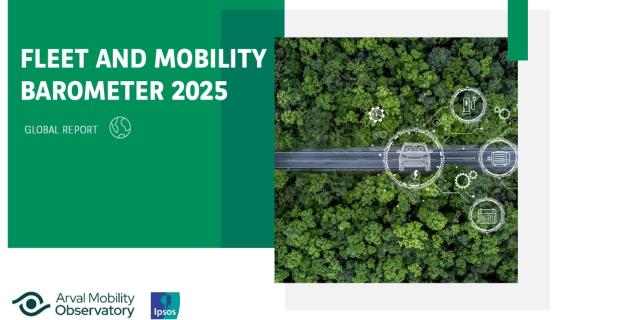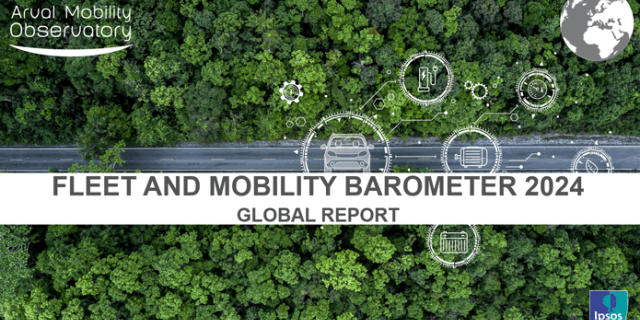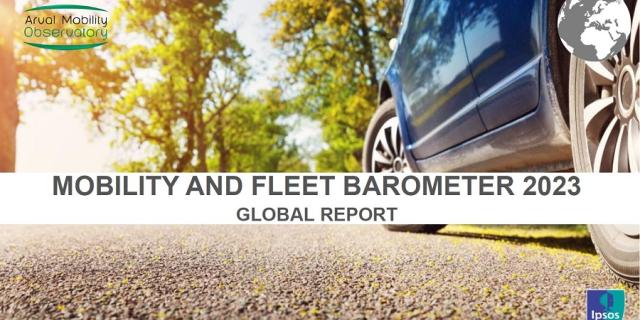Rueil Malmaison, 27 April 2022
The Arval Mobility Observatory publishes its Fleet and Mobility Barometer 2022, showing resilience of fleets, new mobility means adoption and commitment to energy transition of companies in 26 countries.
Download the Arval Mobility Observatory Fleet and Mobility Barometer 2022
The Arval Mobility Observatory, an industry expert in the recording and forecasting of mobility trends, has published the results from its latest barometer and in 2022, a record number of company decision makers were interviewed to gather feedback from 26 countries. The 2022 barometer was conducted between November, 19th 2021 and March, 11th 2022. Even though the survey once again took place in a climate of uncertainty, the growth prospects of company fleets in general as well as full service lease in particular, remain positive overall. The transition to electrification continues, alternative mobility solutions are confirming existing trends and telematics is increasingly seen as a concrete lever to improve Total Cost of Ownership (TCO) and safety in companies’ fleets.
The Fleet & Mobility Barometer 2022 indicates five key macro trends for the foreseeable future:
1. Companies remain confident for their fleet
Fleet and mobility policy decision makers remain optimistic about the future; 94 % of all companies surveyed across the 26 geographies expect their fleet to remain stable or grow over the next three years. Only 6 % anticipate a decrease.
Among companies expecting an increase of their fleet, the main reasons mentioned are the following: 65 % anticipate growth of their businesses resulting in a need for more company vehicles, 29 % see company cars as an important lever for talent recruitment and retention of employees, with 18 % planning to expand their company cars to employees who had no company car before. For the 6% of companies that anticipate a reduction in their fleets, they mention a drop in activities, a drop in the eligibility of employees for a company car or a general reference to Covid-19 is given as an explanation. Compared to a year ago, the link to Covid-19 to explain the reason for an expected decrease or increase in the fleet has fallen from 60 % to 27 % overall.
2. Full service lease should continue to grow across countries and fleets
One third of the companies interviewed consider introducing or further increasing the use of operating lease in their financing and fleet management model. The increasing popularity of full service lease for the years to come stays in line with the levels observed prior to Covid-19. Due to the health crisis as well the subsequent semi-conductor availability challenges leading to increased delivery times, companies have extended their fleets in terms of contract durations. This has led to some lower observed overall growth rates in the industry in recent months and yet it is to be seen as a temporary phenomenon.
Another finding from the survey is that full service lease will increase in all types and sizes of businesses, including the smallest: 37 % of which say they will introduce or increase the use of full service lease in their fleets, a proportion that is getting relatively close to the levels observed in mid sized and large companies for a number of years.
3. Despite some remaining challenges, the energy transition is clearly continuing
Across all countries and companies surveyed, 59 % of companies have already implemented or are considering implementing at least one of the following technologies within the next three years: hybrid vehicles (HEVs), plug-in hybrids (PHEVs) and battery electric vehicles (BEVs) for passenger cars (PCs). 40% of companies already have at least one on fleet today.
Smaller companies are catching up with large corporates on electrified vehicles adoption: 20 % of small companies are already using hybrid passengers cars compared to 23 % of very large companies, 18 % of small companies are already using PHEV for their passenger car fleets compared to 23 % of very large companies and 14 % for 100 % BEV compared to 18 % of very large companies.
The adoption of electrified vehicles is particularly high in Western Europe (UK, Spain, France, and Germany) and Nordic countries (Norway, Sweden, Denmark and Netherlands). In contrast, it is still low in Eastern Europe (Czech Republic, Slovakia, Romania) and even more marginal outside of Europe (Brazil, Chile, Russia, Morocco, Turkey).
The reasons for adopting these technologies as expressed by the decision makers we interviewed, are a desire to have a lower environmental impact (52% for PCs and 48% for LCVs), to reduce fuel expenses (45% for PCs and 44% for LCVs) and to support the company’s image (39 % for PCs and 40 % for LCVs).
Nevertheless, diesel and petrol cars should still represent an important part of the vehicle mix for the foreseeable future. Indeed, companies expect around half of the cars (55%) and six out of ten light commercial vehicles (63 %) to be Internal Combustion Engine vehicles in 3 years. This view is remarkably consistent across fleets of all sizes.
Among the companies currently delaying their adoption of electric vehicles, three of the four top factors mentioned relate to the issue of charging access, whether it is home charging, office charging or publicly available charging facilities and services.
4. Companies are deploying alternative mobility solutions as an add-on to company car fleets
Globally, more than six companies out of 10 have already implemented at least one alternative mobility solution (corporate car sharing, bike leasing or a mobility budget are few of them) .79 % have already implemented or intend to invest in such mobility solutions for the 3 years to come. Penetration of alternative mobility solutions is the highest in Germany, UK and Netherlands (eight companies out of 10 having already implemented such solutions). They are the least widespread in Poland (but still four companies out of 10). In most cases (nine companies out of 10), these solutions are complementary to company cars and not a substitute, most interviewees of the survey indicated that they are not intending to give up all or part of the company car fleet as such.
Partial remote working has started to be introduced in many companies, yet only 14 % today have started or consider adapting their fleet and mobility policies to take this new trend into account.
5. Connected services are increasingly used to manage fleet costs and drive safety
38 % of companies have a telematics tool within their fleet; 26 % for passenger cars and 31 % for LCV fleets. The extent of these connected services increases slightly with the size of the company: 37 % for smaller companies and 40 % amongst the largest companies.
Penetration of telematics is the highest in Brazil, Peru and Chile (around 60 %). It also concerns more than half of the companies in the UK, Czech Republic and Russia. On the other hand, it is still particularly low in Germany and Austria (below 20%).
The main reasons to have connected vehicles, regardless of type, are to locate vehicles or improve vehicle security (39%), to improve operational efficiency (29%), to improve driver safety (31%) and to reduce fleet costs (24%).
“The 2022 Fleet & Mobility barometer is clearly showing us the resilience of fleets in a continually turbulent environment, as the companies decision makers that were interviewed remain optimistic for the future and committed to pursue their investments in sustainable mobility”, said Yaël Bennathan, Head of Arval Mobility Observatory.
Methodology 2021/2022
For this independent survey, 7,576 Fleet Manager interviews were carried out between November 19, 2021 and March 11, 2022 by an independent research company Ipsos. Participants were recruited by telephone with a mix of data collection models: a full interview conducted by phone or recruitment by telephone and a link sent to complete the survey online. Its scope (from 20 to 26 countries), has been extended this year to include most of the European countries (Austria, Deutschland, Belgium, Spain, France, Greece, Italy, Luxemburg, the Netherlands, Poland, Portugal, UK, Czech Republic, Slovakia, Romania, Switzerland, Finland, Denmark, Norway, Sweden) plus the fleet markets of Russia, Turkey, Morocco, Chile, Peru and Brazil. The companies in scope operated at least one vehicle.
The distribution of the interviewees were as follows:
• 33% were companies with less than 10 employees
• 20% were companies with 10 to 99 employees
• 27% were companies with 100 to 249/499/999* employees (*dependent on market)
• 20% were companies with 250/500/1000* employees or more (*dependent on market)











